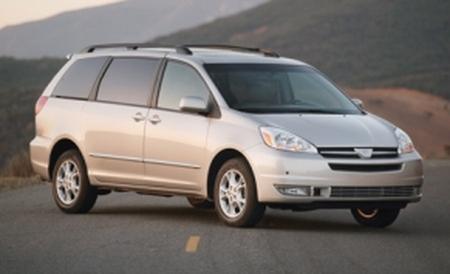My, my, would you just look at our little Sienna. He has grown up and moved away from home. Empty-nesters Mama Camry and Papa Avalon may have shed a tear, but they knew deep in their combustion chambers that if their little vanlet hung around that cramped Kentucky assembly line, with its sedan-based length and width restrictions, his growth potential would forever be stunted to 80-some-thousand annual sales, whereas kicking around an Indiana frat house with those big bruisers, the Sequoia and the Tundra, would make a man out of him.
And sure enough, in March he came out swinging for the bullies of the block from Honda and the Chrysler group. Dimensionally, the 2004 Sienna is within a fist’s width of all the heavyweight minis out there, and it now boasts top passenger space in the minivan class (besting the Odyssey by six cubic feet, mostly in the front seats, and topping the Grand Caravan by 12 cubes). Seating for eight is available, trumping all but the GM minis by one seatbelt. The Sienna also boasts more seats-up stowage, with 44 cubic feet available behind the third seat (the runner-up Honda can tote 38). On the features and gizmos front, the Sienna meets or beats practically every other minivan player, offering everything from a power hatch to all-wheel drive. And even the drivetrain is fortified to nearly class-leading levels.
So how does it all work? Damned impressively, for the most part. When our eight-seater Sienna arrived, we buckled an adult into each seatbelt for a shakedown cruise. With the middle-row seats adjusted to about the center of their six-inch travel, second- and third-row legroom was ample, and all occupants reported reasonably high levels of comfort. Third-seat headrests must be raised to clear adult shoulders, but that makes them safer anyway. The middle occupant in the third row is the only real second-class citizen. The 60/40 split in the rear bench makes the center seat cushion a bit less compliant, and the 52 inches of hiproom isn’t always comfortably divisible by three adult American backsides. The threesome in the much wider middle row reported coast-to-coast comfort after they slid the center seat a bit forward of the two others, to stagger shoulders and hips.
That long-haul comfort extends to the roomy and well-shaped front seats, too. A tilting and telescoping steering wheel ensures an ideal driving position (better than do adjustable foot pedals, in our opinion). Clearly marked controls, back-lit in a striking light-blue shade, do their part to ease fatigue. Mollifying the “are we there yets?” is a DVD player (available with various options packages starting at $3545) that includes video input jacks and a household-type 115-volt plug to power video games and other nannytronics. Roll-down windows in the sliding doors and power rear vent windows are welcome features, but we noted that the sliding doors won’t open fully with the windows down (to avoid guillotining anyone sticking a head out), and we wish the third-row riders could control their own windows as they can in a Kia Sedona (or in the base Sienna CE with manual vents).
The middle-row buckets fold and dump forward easily, leaving a wide path for getting into and out of the third-row seats, but when the middles are returned to upright, they don’t remember their original seatback positions, defaulting instead to a bolt-upright posture not even the most devout Quaker could tolerate. And although the split-folding third row sets the industry standard for ease of use, the middle-row buckets are unwieldy. Each outboard seat weighs 48 pounds, the narrower center one tipped our scales at 54 pounds (it’s reinforced to carry shoulder-belt loads in a crash). And sure, most folks may never need to remove these seats to carry stuff, but to take advantage of Toyota’s clever Front and Center middle-bucket feature that brings a child forward to within runny-nose-swabbing reach of Mom or Dad, one must remove an outboard bucket and then unlatch the middle seat and reposition it 6.7 inches forward. Carefully following the instructions demonstrated effortlessly by the cover-girl spokesmodel on Toyota’s seating video, we ended up sweaty and winded. Another misstep: The one-piece middle-row floor mat doesn’t fit when the center seat is moved forward. Oops.
Dynamically, the Sienna has matured nicely. Its 3.3-liter V-6 puts out just 10 fewer horsepower (230) and identical pound-feet of torque (242) to Honda’s 3.5-liter in the Odyssey and returns better fuel economy (19 city and 27 highway versus 18 and 25). In a drag race, the Toyota will finish a car length or two short, trailing the Honda by 0.3 second to 60 mph and through the quarter-mile, but its times of 7.8 and 16.2 seconds are thoroughly respectable, and the Sienna always seems to champ at the bit. Even with eight passengers onboard, we had no trouble merging to freeway speeds on short uphill on-ramps. Let’s call the power “more than adequate.”


Leave a Reply